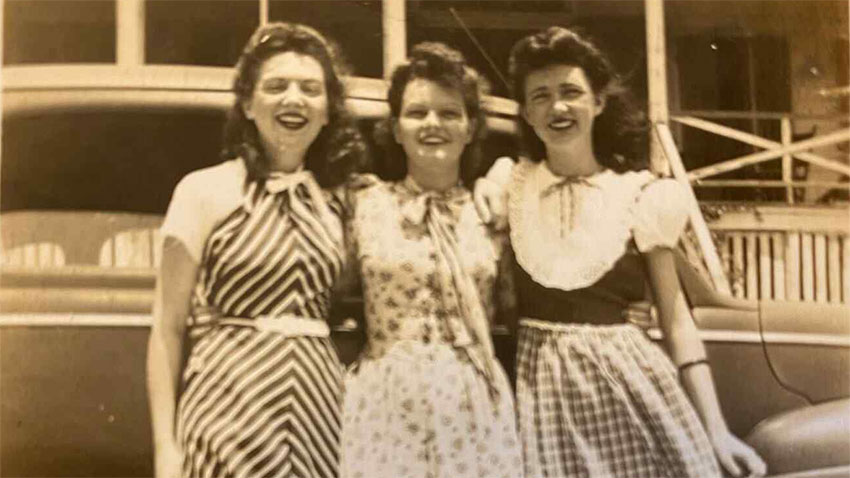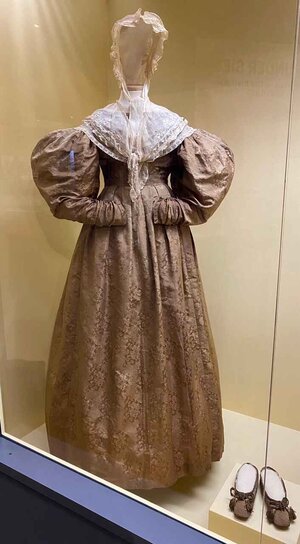
You’ve come a long way, baby. That phrase has a variety of connotations. It implies dramatic change or development, particularly regarding women’s rights issues. Women’s fashions have come a long way, too. They often visually represent social, political and economic norms of the eras, the changing styles illustrating the evolution of woman herself.
ELITE & ELEGANT

It comes as no surprise that women’s fashions among the early Charleston elite emulated the latest styles of London and Paris. That meant silk, satin, lace and damask. For a glimpse into the fashions of the day, look at some of the 18th century portraiture at the Gibbes Museum of Art or visit the Charleston Museum.
Women who were not part of the higher economic and social statuses required a fashion statement a bit simpler but did what they could to infuse some of the latest styles into their modest attire, including wearing dresses made of inferior fabric and adding the all-important gloves and hats.
FLAPPER & DAPPER
The crinoline petticoat became the fashion staple through the next century. Think Scarlett O’ Hara in “Gone with the Wind.” With the tremendous wealth on Lowcountry plantations allowing for the latest trends, it’s no wonder that the Southern belle was stereotyped in film and literature. Today, some Charleston brides still choose this style for their wedding gowns.

However, a new century ushered in a new look, and dress styles became slender and sleek. Then, as women sought more independence and the right to vote, a bolder fashion statement emerged. Hemlines rose to the knee, and “flapper” styles became the rage. Those shiny, short, fringe-trimmed dresses could shimmer and shake while dancing “The Charleston, of course, as women broke all kinds of norms, showing that sometimes rebellion demands respect. The first waves of feminism had begun.
After the 1920s roared, The Great Depression ushered in a serious tone reflected in more modest wear. Yet even during those leaner times, special functions required the glamorous look influenced by cinema: long gloves and an evening gown topped off with a fur stole. One local woman related the story of her grandmother who attended the grand opening of the Dock Street Theater in 1937. “Since it was the Depression, she didn’t have the money to buy a fur. So, she ended up borrowing one from her dear friend whose father was a renowned bootlegger in town, and my grandmother was able to attend the gala decked out in style.”
Proper fashion etiquette was always expected when out and about in Charleston. Local resident Phyllis Dawson Mosley recalled “wearing heels and a dress — always – when shopping on King Street. And anytime you got dressed up, you wore a hat — even to football games.” Jean Moseley Jeffcoat confirmed, You didn’t go on King Street unless you were dressed. And you could always recognize the girls from Ashley Hall (the prestigious girls’ school downtown) because they had on gloves.”
WARTIME WARDROBES

Women’s fashions took on more of a masculine look in the World War Il era with styles borrowed from the uniforms worn by women in the armed forces. These interchangeable separates – blazers, pants and straight skirts – were also more practical for some of the jobs that had been traditionally held by men but were filled by women during the war.
In the evenings, however, femininity was on display in the dance scene. With the prevalence of military personnel in the area, there was no shortage of male dance partners passing through Charleston. And for women, swinging to the music of the Big Band Era required full skirts that were an integral piece of the action. Picture “the Jitterbug.” The visual dynamic created by the movement of the flared skirt only added to the excitement. Those straight skirts would never have made fun like that possible.
In the conservative 1950s, women’s colleges in the Northeast introduced the preppie style, known then as the classic “American Girl” look — blouses with Peter Pan collars, madras (plaid) skirts, Bermuda shorts, pedal pushers (Capri pants), and weejuns (penny loafers). At the same time, men in Ivy League schools began to embrace the seersucker suit, a rather informal attire traditionally worn in the South. The fabric spilled over into women’s fashions, too, in the form of skirts and shorts. Seersucker remains the quintessential look for men and women around Charleston.
A REVOLUTION OF SORTS
The social upheaval of the ’60s incited a fashion revolution: the mini-skirt and mini-dress with bold colors and geometric patterns that mimicked modern art. The 1970s continued to embrace “flower power” and bell-bottom pants. The two decades saw protests by groups who pushed for social and economic equality, including basic human, constitutional and civil rights for women and for African Americans. Black women developed their own unique fashion trend, wearing brightly colored fabric and head scarves borrowed from African tradition.
Charlestonian Alada Shinault-Small began wearing Afro-centric clothing then. “I wrapped my head and wore Berber pants that balloon and taper down — like rapper MC Hammer later wore.” And her mother made her skirts. “There weren’t many local shops that sold the styles back then,” she said. There was a store on Upper King that had the attire and one space in the City Market. When Gallery Chuma was on John Street, they sold clothing and hats from Nigeria. And a lot of people sold out of their homes or trunks.”
Shinault-Small explained that the zenith of the African-infused style was in the 1960s, but fashion has always been important in the Black community. “From coming out of enslavement and trying to fit in, most would agree they had to go above and beyond to compete, no matter how educated or experienced they were — to look a certain way to get respect.” Shinault-Small pointed out that during the civil rights movement of the 1960s, Black protestors and marchers dressed in “church clothes” — men in suits and ties and women wearing hats and gloves. As an example, she described the famous photo of protesters in the 1969 Charleston hospital workers strike, led by Coretta Scott King, and contrasted it to the clothes worn today at Black Lives Matter protests where participants wear graphic t-shirts with pointed messages. “You always dressed up when you marched back then, even when you knew you’d be arrested,” Shinault-Small added.
A BLAST FROM THE PAST
By the 1980s, prevailing fashion trends took a jump back to the 1950s, by revisiting the preppie look with button down collars and khaki, although the preppie style had never really disappeared in Charleston anyway. But the decade also saw advances made by women in the workplace and were reflected in “power dressing – darker colors, pants and blazers. It was considered a professional look, one that was derived from the wardrobe of businessmen.
But the 1990s seemed to be the beginning of do-as-you-please fashion, an affront to the expectations of the aspirational, go-getting culture of women in the previous decade. The wearer could now mix and match different styles rather than follow any particular fashion statement. This trend continues today, with forgotten parts even starting to re-emerge.
TRENDS OF TODAY
According to local fashion designer Devin Smalls, today’s women “are free to just be able to put on what they want and express themselves.” Smalls is the founder of the annual Gullah Gala event which recently celebrated its third year in Charleston. He explained that fashion is a cycle, like the flared pants from the 1970s that are back now. So as a designer, Smalls blends past and current trends in his works. “Fashion is an expression of who you are,” he said.
Women today have achieved higher statuses in the labor force, greater income earnings and more education than their forebears. Those achievements have ushered in fashion trends that personify more self-assuredness rather than adherence to expectations and specific stereotypes. Women are comfortable exhibiting their own personalities and identities through their wardrobe choices. Shinault-Small admits to dressing comfortably and loosely these days to cover up in the sun, wearing gauze pants and big shirts with three-quarter length sleeves. She added, “I’ll accessorize with Afro-centric jewelry if I can’t find something ethnically inspired to wear.”
And with Charleston being home to people of many diverse cultures, it’s not uncommon here to see women of various ethnicities and races wearing clothing reflective of their own cultural backgrounds. And with Charleston being Charleston, some local women are still tied to the tried-and-true local traditions of seersucker and madras. Today’s woman can borrow from a variety of fashion choices and blend them to create a style that is her own.
By Mary Coy